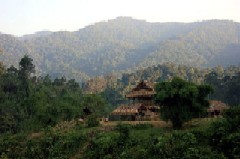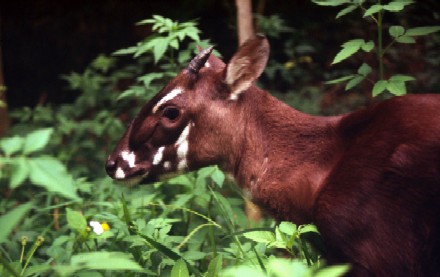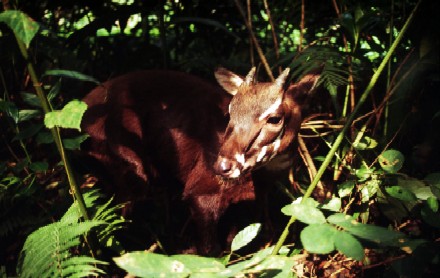Navigation
New Reserves In Vietnam To Protect Saola, One Of The World's Rarest Animals
The provincial People’s Committees of the central Vietnamese provinces of Thua Thien Hue and Quang Nam endorsed a set of conservation actions on September 28, 2007, that will help ensure the saola (Pseudoryx nghetinhensis) will survive in Vietnam.
The provincial People’s Committees of the central Vietnamese provinces of Thua Thien Hue and Quang Nam endorsed a set of conservation actions on September 28, 2007, that will help ensure the saola (Pseudoryx nghetinhensis) will survive in Vietnam.
 |
| Annamite Range in Pu Mat National Park, Vietnam. Photo: Rolf Müller published on Wikipedia |
The new reserves for the saola include are in Vietnam's rugged Annamite Mountains. They are a 121 km2 reserve in Thua Thien Hue and a 121 km2 in Quang Nam. These two reserves are directly adjacent to each other as well as connecting to a 165 km2 expansion to the 220 km2 Bach Ma National Park. The result of this action is the formation of a continuous protected landscape covering approximately 2,920 km2 stretching from the Vietnamese coast to Xe Sap National Biodiversity Conservation Area in Lao PDR. This secures a landscape corridor which is less vulnerable to the impacts of development, climate change and human pressure.
 |
| Saola, Pseudoryx nghetinhensis, (aka Vu Quang ox) 4 - 5 month old female at the Forest Inventory & Planning Institute Botanical Garden. Hanoi, Vietnam Photo: (c) WWF-Canon / David HULSE |
The saola (pronounced: sow-la) was discovered just 15 years ago by a team of scientists from WWF and the Vietnamese Ministry of Forestry. It was the first large mammal discovered anywhere in the world since 1936. Scientists are still trying to figure out whether the saola is a goat, antelope or cow species. Only eleven have ever been recorded alive and fewer than 250 are estimated to exist today.
The discovery came about when a team of scientists from WWF and Vietnam's Ministry of Forestry were shown a pair of long, almost straight, horns from a large mammal while conducting a 1992 survey in central Vietnam. They didn't know what to think. But after discussions with local villagers and the discovery of two additional pairs of horns, they were amazed at what they had -- a new species of large mammal, one of only five discovered in the last 100 years. After further scientific examination of the horns, the saola was officially described in 1993.
“The saola population in Thue Thien Hue and Quang Nam provinces offers the best, if not the only, chance for this unique flagship species of the Annamite Mountains to survive in Vietnam,” said Dr. Barney Long, Central Truong Son Conservation Landscape Coordinator for WWF Greater Mekong – Vietnam Programme. “Establishing these three extensions to the Vietnamese protected area network helps create an essential stronghold for the saola to survive. Moreover, the area holds a suite of endemic and endangered species such as the Truongson muntjac, red-shanked douc and white-cheeked crested gibbon as well as many other newly and yet to be described species.”
The saola is threatened by extinction primarily due to hunting which is prevalent throughout the species’ range. Research conducted by WWF over the last year has indicated a rapid decline in saola numbers in the area since the wire snare-trap was introduced in the mid 1990s. Hunting is driven by demand for wild meat in the affluent urban centers. Lines of hundreds of snares are set at a time and hunting dogs also pose a large threat to the saola due to their distinctive defensive response to the presence of dogs.
“This is a momentous occasion and one which marks the culmination of years of hard work by the Forest Protection Departments of Thua Thien Hue and Quang Nam provinces as well as Bach Ma National Park,” said Mrs. Tran Minh Hien, WWF Greater Mekong – Vietnam Programme Director.
 |
| Saola 4 - 5 month old female at the Forest Inventory & Planning Institute Botanical Garden. Hanoi, Vietnam Photo: (c) WWF-Canon / David HULSE |
“The saola acts as an emblem of conservation efforts in Vietnam, yet it remains on the brink of extinction and so WWF is committed to supporting local agencies to develop locally appropriate interventions to ensure its survival.”
In recognition of these commitments that represent critical first steps in the conservation of the saola, WWF honored the Forest Protection Departments of Thua Thien Hue and Quang Nam as well as Bach Ma National Park with a ‘Leaders for a Living Planet’ Award.
Note:
The full WWF-US recent story on Saola are available at http://worldwildlife.org/wildplaces/flm/updates/saola.cfm
And
The story of the WWF discovery of the saola, “WWF Scientists Make Landmark Discoveries” is available at: http://worldwildlife.org/wildplaces/flm/results.cfm.
Contacts:
Dr. Barney Long
Central Truong Son Conservation Landscape Coordinator
WWF Greater Mekong – Vietnam Program
Tel/Fax: + 84 (0)510 810735
Cell: + 84 091 4085315
barney.long@wwfgreatermekong.org
Dr. Chris Dickinson
Green Corridor Project Technical Advisor
WWF Greater Mekong – Vietnam Program
chris.dickinson@wwfgreatermekong.org
Additional links;
Search
Latest articles
Agriculture
- World Water Week: Healthy ecosystems essential to human health: from coronavirus to malnutrition Online session Wednesday 24 August 17:00-18:20
- World Water Week: Healthy ecosystems essential to human health: from coronavirus to malnutrition Online session Wednesday 24 August 17:00-18:20
Air Pollution
- "Water and Sanitation-Related Diseases and the Changing Environment: Challenges, Interventions, and Preventive Measures" Volume 2 Is Now Available
- Global Innovation Exchange Co-Created by Horizon International, USAID, Bill and Melinda Gates Foundation and Others
Biodiversity
- It is time for international mobilization against climate change
- World Water Week: Healthy ecosystems essential to human health: from coronavirus to malnutrition Online session Wednesday 24 August 17:00-18:20
Desertification
- World Water Week: Healthy ecosystems essential to human health: from coronavirus to malnutrition Online session Wednesday 24 August 17:00-18:20
- UN Food Systems Summit Receives Over 1,200 Ideas to Help Meet Sustainable Development Goals
Endangered Species
- Mangrove Action Project Collaborates to Restore and Preserve Mangrove Ecosystems
- Coral Research in Palau offers a “Glimmer of Hope”
Energy
- Global Innovation Exchange Co-Created by Horizon International, USAID, Bill and Melinda Gates Foundation and Others
- Wildlife Preservation in Southeast Nova Scotia
Exhibits
- Global Innovation Exchange Co-Created by Horizon International, USAID, Bill and Melinda Gates Foundation and Others
- Coral Reefs
Forests
- NASA Satellites Reveal Major Shifts in Global Freshwater Updated June 2020
- Global Innovation Exchange Co-Created by Horizon International, USAID, Bill and Melinda Gates Foundation and Others
Global Climate Change
- It is time for international mobilization against climate change
- It is time for international mobilization against climate change
Global Health
- World Water Week: Healthy ecosystems essential to human health: from coronavirus to malnutrition Online session Wednesday 24 August 17:00-18:20
- More than 400 schoolgirls, family and teachers rescued from Afghanistan by small coalition
Industry
- "Water and Sanitation-Related Diseases and the Changing Environment: Challenges, Interventions, and Preventive Measures" Volume 2 Is Now Available
- Global Innovation Exchange Co-Created by Horizon International, USAID, Bill and Melinda Gates Foundation and Others
Natural Disaster Relief
- STOP ATTACKS ON HEALTH CARE IN UKRAINE
- Global Innovation Exchange Co-Created by Horizon International, USAID, Bill and Melinda Gates Foundation and Others
News and Special Reports
- World Water Week: Healthy ecosystems essential to human health: from coronavirus to malnutrition Online session Wednesday 24 August 17:00-18:20
- STOP ATTACKS ON HEALTH CARE IN UKRAINE
Oceans, Coral Reefs
- World Water Week: Healthy ecosystems essential to human health: from coronavirus to malnutrition Online session Wednesday 24 August 17:00-18:20
- Mangrove Action Project Collaborates to Restore and Preserve Mangrove Ecosystems
Pollution
- Zakaria Ouedraogo of Burkina Faso Produces Film “Nzoue Fiyen: Water Not Drinkable”
- "Water and Sanitation-Related Diseases and the Changing Environment: Challenges, Interventions, and Preventive Measures" Volume 2 Is Now Available
Population
- "Water and Sanitation-Related Diseases and the Changing Environment: Challenges, Interventions, and Preventive Measures" Volume 2 Is Now Available
- "Water and Sanitation-Related Diseases and the Changing Environment: Challenges, Interventions, and Preventive Measures" Volume 2 Is Now Available
Public Health
- Honouring the visionary behind India’s sanitation revolution
- Honouring the visionary behind India’s sanitation revolution
Rivers
- World Water Week: Healthy ecosystems essential to human health: from coronavirus to malnutrition Online session Wednesday 24 August 17:00-18:20
- Mangrove Action Project Collaborates to Restore and Preserve Mangrove Ecosystems
Sanitation
- Honouring the visionary behind India’s sanitation revolution
- Honouring the visionary behind India’s sanitation revolution
Toxic Chemicals
- "Water and Sanitation-Related Diseases and the Changing Environment: Challenges, Interventions, and Preventive Measures" Volume 2 Is Now Available
- Actions to Prevent Polluted Drinking Water in the United States
Transportation
- "Water and Sanitation-Related Diseases and the Changing Environment: Challenges, Interventions, and Preventive Measures" Volume 2 Is Now Available
- Urbanization Provides Opportunities for Transition to a Green Economy, Says New Report
Waste Management
- Honouring the visionary behind India’s sanitation revolution
- Honouring the visionary behind India’s sanitation revolution
Water
- Honouring the visionary behind India’s sanitation revolution
- Honouring the visionary behind India’s sanitation revolution
Water and Sanitation
- Honouring the visionary behind India’s sanitation revolution
- Honouring the visionary behind India’s sanitation revolution

